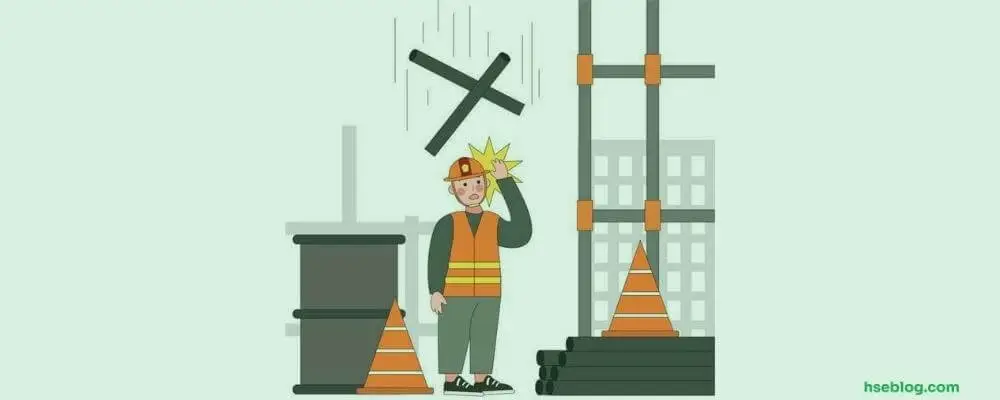Have you ever been working on a construction site and heard something falling overhead? Chances are, whatever it was probably wasn’t supposed to fall and posed a potential hazard to you. This blog post will look at some of the most common hazards of striking moving and flying objects. By understanding these hazards, you can take steps to protect yourself from them.
Reducing the risk of injuries from moving and flying objects is an important part of workplace safety. However, many workers aren’t aware of the dangers posed by these hazards and don’t take proper precautions to protect themselves. Let’s look at some of the most common hazards of striking by moving and flying objects.
Being struck by an object or piece of equipment resulted in 473 work-related deaths in 2011, according to the 2014 edition of the National Safety Council’s “Injury Facts.” OSHA notes that seemingly innocuous activities can have deadly consequences in case reports of deaths due to moving and flying objects. In one example, a worker stood under a scaffold where ladders were being hoisted. The ladder sections fell 50 feet, striking the worker – not wearing head protection – and killing him.
Moving and Flying Objects Hazards
Many potential hazards are associated with being struck by moving and flying objects. These hazards can range from minor injuries to severe injuries or even death. Some of the most common hazards include:
1. Typical Moving Object Hazards
- Falling Objects: When objects aren’t properly fastened or secured, they can fall, injuring those standing or working beneath them.
- Crushing Incidents: Individuals can find themselves trapped and potentially crushed between two objects moving in unison or opposite directions.
- Shearing Dangers: If people aren’t adequately safeguarded, the moving components of machinery can result in shearing injuries, where a part of the body is cut off or severely damaged.
- Cutting Risks: Carelessness around machinery with rotating blades can lead to serious cuts or even amputations.
- Electrical Perils: If individuals come into contact with exposed electrical wiring, it can lead to electric shock or electrocution, posing serious risks.
- Fire Threats: Machinery that is not well-maintained can overheat, triggering fires that can result in burns and other injuries.
- Chemical Risks: Chemical substances can escape or spill from their containers, causing injuries through contact, inhalation, or even explosion.
- Striking Hazards: Workers can be struck by moving machinery, vehicles, or parts, causing potential injuries ranging from minor bruising to serious trauma.
- Entanglement or Entrapment: Loose clothing, hair, or body parts can become entangled in moving machinery, leading to severe injuries or fatalities.
- Noise Hazards: Moving machinery often creates high levels of noise, which over time, can lead to hearing damage or loss.
- Vibration Hazards: Regular exposure to vibration from machinery or vehicles can cause various health issues, including hand-arm vibration syndrome (HAVS) and whole-body vibration (WBV) related issues.
- Ejection of Material: Some machinery, especially cutting or shaping tools, can eject material at high speeds, posing a risk of injury.
Understanding these hazards associated with moving objects is crucial for maintaining safety at the workplace. It’s important to always stay vigilant, use necessary personal protective equipment (PPE), and follow safety protocols to mitigate these risks.

2. Typical Flying Object Hazards
- Debris from Power Tools: Power tools can eject pieces of material, creating a hazard. This is particularly true of tools that cut, drill or grind materials like wood, metal, or stone.
- Compressed Air and Fluids: Compressed air or hydraulic lines can rupture and eject high-speed fluids or objects.
- Ejected Machinery Parts: In some cases, machinery parts can dislodge and fly out. This can happen if the machine is poorly maintained or if there is a mechanical failure.
- Projectiles from Explosives: In industries where explosives are used, such as mining or construction, there’s a risk of materials being launched at high speed.
- High-Speed Processing Equipment: In industries involving high-speed processing or manufacturing, materials or objects can sometimes be ejected if a malfunction occurs or materials are loaded improperly.
- Airborne Particles: Some processes can generate airborne particles that may pose a hazard. For instance, sandblasting or certain manufacturing processes can create a cloud of small particles that can damage the eyes or lungs.
- Inadequate Securing of Loads: If loads are not properly secured on lifting devices, items can fall and then become airborne hazards.
- Mishandled Tools: Hand tools that are mishandled can become airborne. This is especially true for thrown, dropped, or misused tools.
- High Winds: In outdoor settings, high winds can cause objects to become airborne, such as construction materials, debris, or tools.
It’s crucial that workers are aware of these potential hazards and that they take appropriate steps to protect themselves, including using protective equipment, maintaining a safe distance from potential hazards, and ensuring equipment is used and maintained correctly.
Controls for Moving and Flying Objects Hazards
Identifying hazards is the first step to preventing them. The next step involves implementing controls to minimize or eliminate the risks. Here are some common strategies for controlling the hazards of moving and flying objects.
- Risk Assessment and Planning: Conduct a thorough risk assessment before starting work. Identify potential hazards and consider how to eliminate or reduce them. When planning, consider the sequence of work to minimize exposure to hazards.
- Use of Personal Protective Equipment (PPE): Wearing appropriate PPE, such as safety glasses, hard hats, and safety footwear, can provide a layer of protection against moving and flying objects.
- Equipment Inspection: Regularly inspect tools, machinery, and equipment to ensure they are in good working condition. This includes checking that all guards are in place and that objects at height are properly secured.
- Housekeeping: Maintain a clean and organized workplace. This helps to prevent trips, slips, and falls, and it can also make it easier to spot potential hazards.
- Training: Provide workers with the necessary training to understand the hazards associated with their work and the precautions they must take.
- Signage: Use appropriate signage to warn workers of potential hazards, such as areas where objects may fall or fly.
- Exclusion Zones: Where possible, create exclusion zones around areas with a risk of falling objects. These zones should be clearly marked and access restricted.
- Securing of Loads: Ensure all loads are properly secured before moving. Use appropriate restraints and lifting equipment.
- Tool tethering: When tools are being used at height, consider using tool tethers to prevent tools from falling.
- Safe Systems of Work: Establish safe systems of work that include safe procedures for handling and storing materials, particularly those at height.
- Emergency Preparedness: Develop an emergency response plan in case of an incident involving moving and flying objects.
Implementing these strategies can greatly reduce the risk of injuries from moving and flying objects at the workplace. It’s important to remember that safety is everyone’s responsibility. A safe work environment benefits everyone – workers, management, and visitors alike. Always be vigilant, and never hesitate to report potential hazards.

Continuous Monitoring and Improvement
Even after controls have been implemented, it’s essential to maintain a continuous monitoring system to ensure the ongoing effectiveness of the measures put in place. Here are some strategies to ensure constant safety:
- Regular Safety Audits: Conduct safety audits at regular intervals to check if the implemented safety measures are working as intended. If any deficiencies are found, take immediate corrective actions.
- Regular Toolbox Talks: Toolbox talks or safety meetings can be held regularly to discuss specific safety issues related to the job. These are excellent opportunities to refresh employees’ memory about safety procedures, discuss recent incidents, and discuss potential hazards.
- Incident Reporting and Investigation: Encourage employees to report safety incidents or near-misses. Investigate these incidents to understand what went wrong and how to prevent similar incidents.
- Updates on Safety Guidelines: With advancements in technology and changes in regulations, safety guidelines may also need updates. Ensure your safety guidelines are up-to-date and communicated effectively to all employees.
- Encouraging a Safety Culture: Foster a culture of safety within your organization. Workers should feel comfortable expressing their safety concerns and be encouraged to contribute to improving safety measures.
- Involvement of Top Management: The involvement of top management in safety activities can be very impactful. It can demonstrate the organization’s commitment to safety, which can be motivating for workers.
- Use of Technology: Consider using technology to improve safety. For instance, drones can inspect high or difficult-to-reach places, and wearable technology can help monitor workers’ health and safety.
Conclusion
In conclusion, the hazards of moving and flying objects are prevalent in various workplaces and can lead to significant injuries or fatalities if not properly managed. Recognizing these hazards and implementing control measures are crucial to fostering a safe working environment.
Whether the danger of falling objects on a construction site, high-speed particles in a manufacturing facility, or mishandled tools in a repair shop, each set has unique risks requiring comprehensive risk assessments and planning. Key strategies such as maintaining the workplace, using Personal Protective Equipment (PPE), conducting regular equipment inspections, and providing adequate training can mitigate these hazards.
Moreover, continuous monitoring and improvements to safety protocols are necessary for maintaining an effective safety culture. Regular safety audits, toolbox talks, incident reporting, and updates on safety guidelines are essential to ensure the continued effectiveness of safety measures. The involvement of top management and technology adoption can also enhance safety efforts.
Ultimately, safety is a collective responsibility. A safe work environment protects employees and contributes to increased productivity and morale. Therefore, every effort must be taken to minimise the risk of hazards from moving and flying objects.

